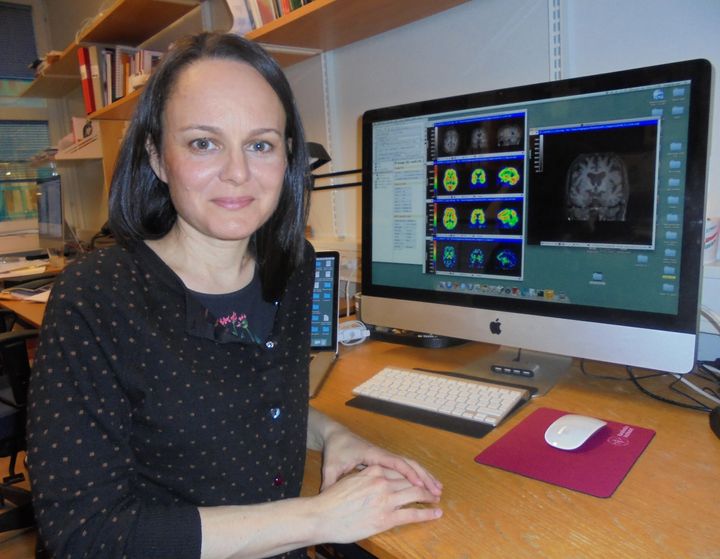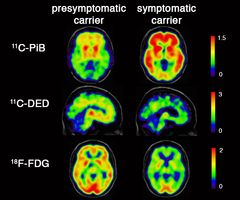Inflammatory changes in the brain twenty years before Alzheimer onset
Roughly twenty years before the first symptoms of Alzheimer's disease appear inflammatory changes in the brain can be seen, according to a new study from Sweden's Karolinska Institutet published in the medical scientific journal Brain. The findings of the researchers, who monitored several pathological changes in the brain, suggest that activation of astrocytes at an early stage can greatly influence the development of the disease.

Alzheimer's disease is characterised by the atrophy of brain neurons, especially those involved in memory, and is our most common dementia disease. Exactly what causes the cells to die is not known, but many years before the first symptoms present themselves, pathological changes occur, such as the deposition of the protein amyloid in the form of amyloid plaques, the accumulation of tau proteins and inflammatory changes that eventually degrade the points of contact between neurons. Exactly when the changes take place along this chain of events remains, however, an unanswered question.
By studying families of people with known Alzheimer's mutations and who therefore run a much higher risk of developing the disease, the researchers were able to examine changes that appear at a very early stage of the disease. The study included members of families with four different known Alzheimer's mutations and a group of patients with non-inherited, 'sporadic' Alzheimer's disease. All participants underwent memory tests and scans using PET (positron emission tomography), whereby radioactive tracer molecules with a short half-life are introduced into the brain via injection into the blood. For this study, the team used the tracer molecules PIB, Deprenyl and FDG to study the amount of amyloid plaques, inflammatory changes in the form of astrocyte activation, astrocytes being the most common type of glial (supporting) cell in the brain. They also studied neuronal function in the brain by measuring glucose metabolism (FDG). In order to monitor the changes over time, the PET scans were repeated after three years for half of the just over fifty participants.
The mutation carriers were found to have amyloid plaque and inflammatory changes almost twenty years before the estimated debut of memory problems. The number of astrocytes reached a peak when the amyloid plaque started to accumulate in the brain, and neuronal function, as gauged by glucose metabolism, began to decline roughly seven years before the expected disease symptoms. The individuals from families with inherited Alzheimer's who did not carry any mutation showed no abnormal changes in their brain.
”Inflammatory changes in the form of higher levels of brain astrocytes are thought to be a very early indicator of disease onset,” explains principal investigator Professor Agneta Nordberg at the Department of Neurobiology, Care Sciences and Society, Center for Alzheimer Research at Karolinska Institutet. ”Astrocyte activation peaks roughly twenty years before the expected symptoms and then goes into decline, in contrast to the accumulation of amyloid plaques, which increases constantly over time until clinical symptoms show. The accumulation of amyloid plaque and the increase in number of astrocytes therefore display opposing patterns along the timeline.” These studies demonstrate that the pathological processes that lead ultimately to Alzheimer's disease commence many years before symptoms start to show, and that it should be possible to provide early prophylactic or disease modifying treatment. According to the researchers behind the study, the findings indicate that astrocytes can be a possible target for new drugs. First author of the study is Elena Rodriguez-Vieitez, PhD, senior researcher at Karolinska Institutet's Department of Neurobiology, Care Sciences and Society. The study was financed by grants from, among others, the Swedish Research Council, the Swedish Foundation for Strategic Research (SFF), the Knut and Alice Wallenberg Foundation, the Stockholm County Council/KI ALF fund, Swedish Brain Power, the Swedish Brain Fund, and a GE Healthcare unrestricted research grant. Publication: 'Diverging longitudinal changes in astrocytosis and amyloid PET in autosomal-dominant Alzheimer's disease', Elena Rodriguez-Vieitez, Laure Saint-Aubert, Stephen F. Carter, Ove Almkvist, Karim Farid, Michael Schöll, Konstantinos Chiotis, Steinunn Thordardottir, Caroline Graff, Anders Wall, Bengt Långström and Agneta Nordberg, Brainx, first published online 26 January 2016.
Contacts
For further questions, please contact:
Agneta Nordberg, PhD, Professor
Center for Alzheimer Research
Department of Neurobiology, Care Sciences and Society, Karolinska Institutet
Phone: +46 (0)8 58585467 or +46 (0)705107685
E-mail: Agneta.K.Nordberg@ki.se
Elena Rodriguez-Vieitez, PhD, Senior researcher
Center for Alzheimer Research
Department of Neurobiology, Care Sciences and Society, Karolinska Institutet
Phone: +46 (0)8 58585466
E-mail: elena.rodriguez-vieitez@ki.se
To contact the Press Office and download images (http://ki.se/pressroom)
Images



Karolinska Institutet (http://ki.se/english) is one of the world's leading medical universities. Its vision is to significantly contribute to the improvement of human health. Karolinska Institutet accounts for over 40 per cent of the medical academic research conducted in Sweden and offers the country´s broadest range of education in medicine and health sciences. The Nobel Assembly at Karolinska Institutet selects the Nobel laureates in Physiology or Medicine.
Subscribe to releases from Karolinska Institutet - English
Subscribe to all the latest releases from Karolinska Institutet - English by registering your e-mail address below. You can unsubscribe at any time.
Latest releases from Karolinska Institutet - English
New method reveals how the brain and inner ear are formed3.4.2025 20:00:00 CEST | Pressmeddelande
Researchers at Karolinska Institutet have developed a method that shows how the nervous system and sensory organs are formed in an embryo. By labelling stem cells with a genetic ‘barcode’, they have been able to follow the cells’ developmental journey and discover how the inner ear is formed in mice. The discovery, published in Science, could provide important insights for future treatment of hearing loss.
Fluoride in drinking water is associated with impaired childhood cognition7.3.2025 15:30:00 CET | Pressmeddelande
Elevated concentrations of fluoride can occur in well water, and in some countries, it is added to drinking water to counteract caries in the population. A study from Karolinska Institutet in Sweden now supports a few previous studies indicating that exposure to fluoride during the fetal stage or early childhood may impair cognition in children. The study is published in the journal Environmental Health Perspectives.
Children with ARFID face increased risk of disease17.2.2025 17:00:00 CET | Pressmeddelande
Children with avoidant restrictive food intake disorder (ARFID) have an elevated risk of developing psychiatric and physical conditions, a new study from Karolinska Institutet published in JAMA Pediatrics reports. The study highlights the importance of early identification to improve care of these children.
Preterm babies receive insufficient pain management27.1.2025 15:29:17 CET | Pressmeddelande
A large proportion of babies born very early need intensive care, which can be painful. But the healthcare system fails to provide pain relief to the full extent. This is shown by the largest survey to date of pain in neonatal care, now published in the journal Pain.
New study paves way for immunotherapies tailored for childhood cancers20.1.2025 17:00:00 CET | Pressmeddelande
Researchers at Karolinska Institutet and the Astrid Lindgren Children’s Hospital in Sweden have determined how children’s immune systems react to different kinds of cancer depending on their age. The study, which is published in the journal Cell, reveals significant differences between the immune response of children and adults, and has the potential to lead to new tailored treatments for children with cancer.
In our pressroom you can read all our latest releases, find our press contacts, images, documents and other relevant information about us.
Visit our pressroom